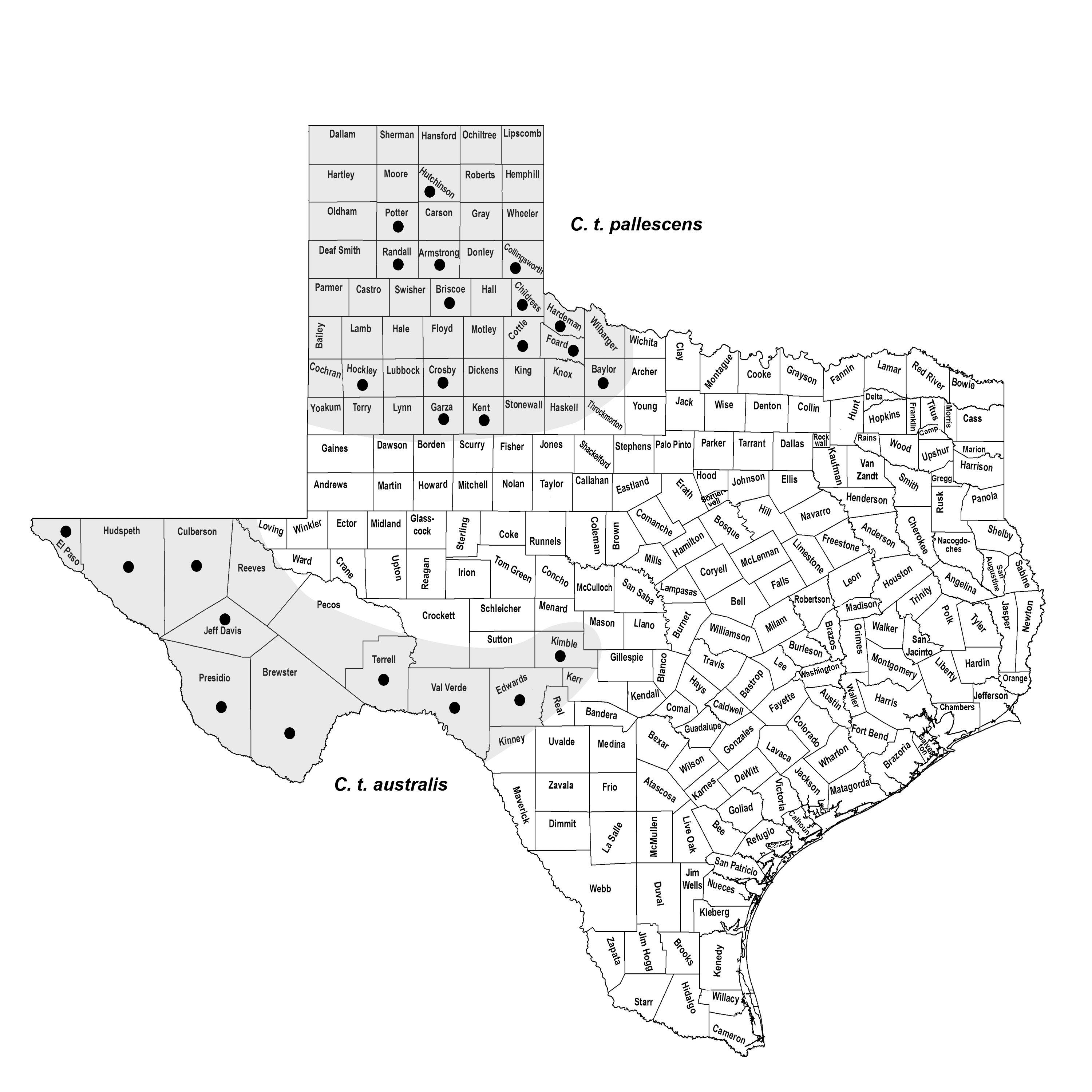TOWNSEND'S BIG-EARED BAT
Corynorhinus townsendii (Cooper 1837)
Order Chiroptera : Family Vespertilionidae
DESCRIPTION. A medium-sized bat with extremely long ears and a small glandular outgrowth on each side of the snout. Upperparts near clove brown on back, wood brown on sides, underparts slightly paler; membrane between hind legs full, wide, and hairless. The combination of large flexible ears, nearly uniform color, and the lumps on the snout identifies this bat. Dental formula: I 2/3, C 1/1, Pm 2/3, M 3/3 × 2 = 36. Averages for external measurements: total length, 100 mm; tail, 46 mm; foot, 11 mm; ear, 35 mm; forearm, 44 mm. Weight, 7–12 g.

DISTRIBUTION. Townsend's big-eared bat ranges across the entire western United States (with disjunct populations in the Ozarks and the Appalachians) and has been documented in suitable habitat in the western half of Texas, where it has been recorded in the northern High Plains and adjacent Rolling Plains and from the Trans-Pecos and western Edwards Plateau vegetation regions.

SUBSPECIES. Corynorhinus t. pallescens in the northern part of its Texas range and C. t. australis in the western and southern regions.
HABITS. The distribution of this bat is correlated largely with rocky situations where caves or abandoned mine tunnels are available. They do not seem to utilize crevices in such sites and may occasionally inhabit old buildings. These bats inhabit gypsum caves found throughout northern Texas and are common in caves and mine tunnels of the Trans-Pecos.
Townsend's big-eared bats hibernate throughout their range during winter months when temperatures are between 0°C and 11.5°C. The bats hibernate in tight clusters, which may help stabilize body temperature against external changes in temperature. While torpid, the large ears are rolled up and laid back against the animal's neck. Males may select warmer hibernacula than females and are more easily aroused and active in winter than are females. Their winter sleep is interrupted by frequent periods of wakefulness during which they move about in the caves or from one cave to another. They become very fat before hibernation. This fat provides them with sufficient food to maintain their lowered metabolism during the winter months when they do not eat. Males and females occupy separate roosting sites during summer. During this season, males appear to lead a solitary lifestyle, while females and young form maternity colonies that may number 12–200, although in the eastern United States colonies of 1,000 or more are known. These bats emerge late in the evening to forage and are swift, highly maneuverable fliers. Prey items include small moths, flies, lacewings, dung beetles, and sawflies.
The single young is born in late May to early June, at least in Texas. The baby bat weighs approximately 2.4 g at birth and is pink, naked, and completely helpless. At 4 days of age the newborn bat begins to display hair growth and by 1 month of age is volant and nearly adult size. At 2 months of age the juveniles are weaned and the nursery colonies begin to disperse.
POPULATION STATUS. Uncommon, year-round resident. Although this species occurs in suitable habitat (preferring caves and mine tunnels) in the western half of the state, Townsend's big-eared bat appears to have declined in Texas as a result of the practice of blasting old mine tunnels to shut them off permanently, which destroys not only significant numbers of the bats but also permanently removes many of their roosting sites.
CONSERVATION STATUS. The IUCN status of Townsend's big-eared bat is least concern; previously both federal and state government lists regarded it as a species of concern, but it is not currently included in their listing of concerned species. This is definitely a bat that bears watching in the future in Texas.
From The Mammals of Texas, Seventh Edition by David J. Schmidly and Robert D. Bradley, copyright © 1994, 2004, 2016. Courtesy of the University of Texas Press.
Natural Science Research Laboratory
-
Address
Museum of Texas Tech University, 3301 4th street, Lubbock, TX 79409 -
Phone
806.742.2486 -
Email
nsrl.museum@ttu.edu

